The article below by M. L. Chaumont on the Greek historian Arrian (2nd century CE) was originally published in the Encyclopedia Iranica on December 15, 1986 and last updated on August 15, 2011. This article is available in print (Vol. II, Fasc. 5, pp. 523-524).
Kindly note that the pictures and accompanying captions below do not appear in the original Encyclopedia Iranica publication.
Arrian, L. Flavius Arrianus, Greek historian from Bithynia, born in Nicomedia, whose father had obtained Roman citizenship. He held very high positions. The apex of his career occurred under the emperor Hadrian who appointed him governor of Cappadocia in 131 A.D. His reputation as a historian earned him the name the new Xenophon. Achaemenid and Parthian Iran occupied an important place in Arrian’s historical work, including: (1) the Anabasis, which treats Alexander’s expeditions; its supplement, the History of India; and the History of Events after Alexander; and (2) the Parthica or History of the Parthians.
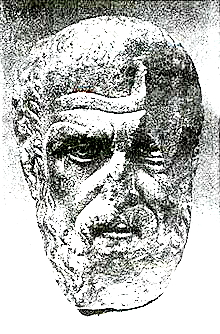 Portrait of a bearded man attributed to Flavius Arrianus (Source: Fernhill.com).
Portrait of a bearded man attributed to Flavius Arrianus (Source: Fernhill.com).
The Anabasis is divided into seven books on the model of the Anabasis of Xenophon. Written in a sober and simple style, it is a mine of information on Iran toward the end of the Achaemenid period. It not only describes the famous battles of the Macedonian forces against the armies of Darius III Codomannus, but it also contains many details about the provinces and peoples of the Persian empire, as well as its leading generals and satraps.
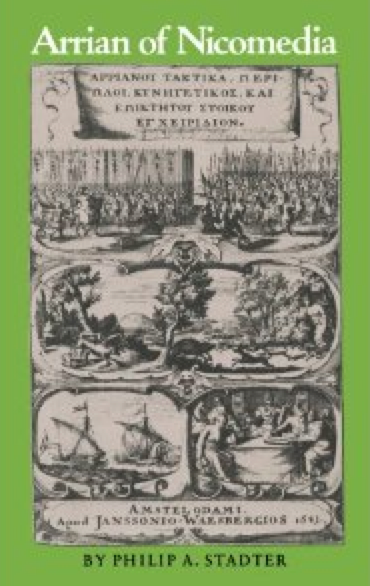 Philip A. Stadter’s 2010 book “Arrian of Nicomedia” (University of North Carolina Press; for more information see Amazon…)
Philip A. Stadter’s 2010 book “Arrian of Nicomedia” (University of North Carolina Press; for more information see Amazon…)
The principal sources of the Anabasis are Ptolemy, the son of Lagus, and Aristobulus of Cassandreia; these were the authors who Arrian considered most reliable, as he remarks in his preface. Both of them had taken part in Alexander’s campaigns. The former, of Macedonian nobility, had been a member of the bodyguard and the companion in arms of the conqueror before becoming, after Alexander’s death, satrap, and then king of Egypt (Ptolemy I Soter). The second had also belonged to Alexander’s entourage, but in a more modest position, as an engineer or architect. Not even the titles of the works of Ptolemy and Aristobulus have survived, nor do we know what they covered.
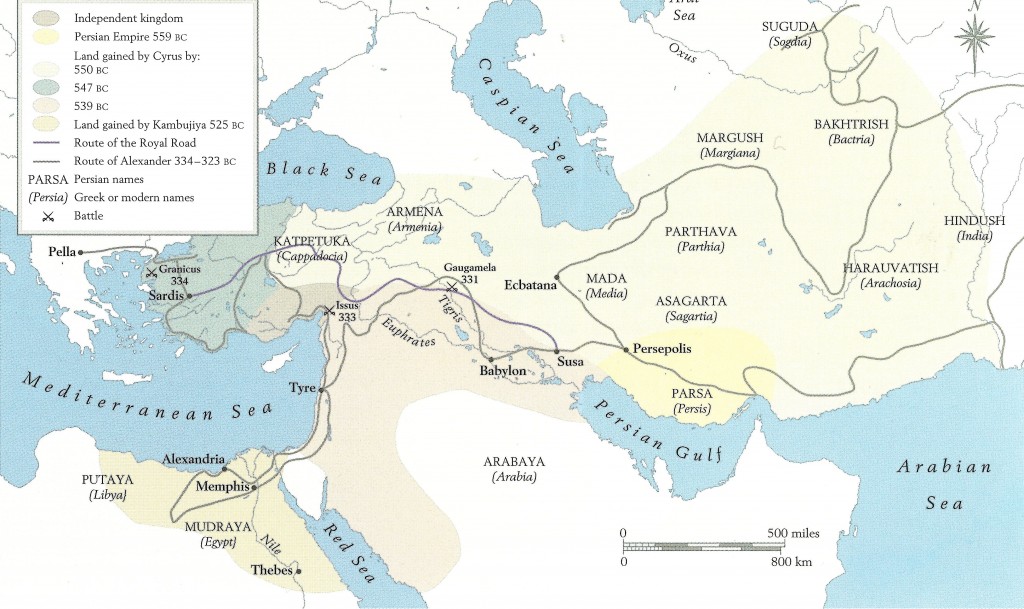 Map of the Achaemenid Empire drafted by Kaveh Farrokh on page 87 (2007) for the book Shadows in the Desert: Ancient Persia at War-Персы: Армия великих царей-سایههای صحرا-; Arrian has provided valuable descriptions of the provinces and peoples od the ancient Persian Empire.
Map of the Achaemenid Empire drafted by Kaveh Farrokh on page 87 (2007) for the book Shadows in the Desert: Ancient Persia at War-Персы: Армия великих царей-سایههای صحرا-; Arrian has provided valuable descriptions of the provinces and peoples od the ancient Persian Empire.
The agreement between Ptolemy and Aristobulus on certain points is underlined by Arrian, e.g., Alexander’s generous treatment of the mother, wife, and children of Darius III, taken prisoner at the battle of Issus in October, 333 (Anabasis 2.12.3-6). Similarly, they are agreed that the battle that decided the fate of the Persian empire took place, not at Arbela, as is the general consensus, but at a small Assyrian village, Gaugamela (now Tell Gōmēl) on the Bumelus river (now Gōmēl-sū), 500 or 600 stades from Arbela (ibid., 6.11.5-6). There are instances where the two authors disagree, which Arrian does not fail to note.
Arrian refers to Ptolemy on several occasions, e.g., regarding the intervention of Darius’ mother in favor of the vanquished Uxii (in Ḵūzestān). They were allowed to keep their possessions in exchange for the payment of an annual tribute (ibid., 3.17.6). Probably from the same source is the passage concerning the submission of this bellicose people, who controlled the passes that gave access to Fārs (the Persian Gates) and the taking of these passes in spite of the resistance of the satrap Ariobarzanes (ibid., 3.17. 6; 3.18, 2; cf. E. Kornemman, Die Alexandergeschichte, pp. 56ff. and now W. Heckel, “Alexander at the Persian Gates,” Athenaeum 58, 1980, pp. 168-74). Another example is the account of Bessus, regicide and usurper, who was captured by the soldiers of Ptolemy himself in a village of Bactriana. Arrian also mentions the different version of this event by Aristobulus (cf. L. Pearson, The Lost Histories, p. 166). Again from Ptolemy’s work is the text of the correspondence exchanged between Darius III (in flight) and Alexander after Issus (Anabasis 2.14.1-9; cf. Kornemann, op. cit., p. 115, defending the authenticity of this correspondence).
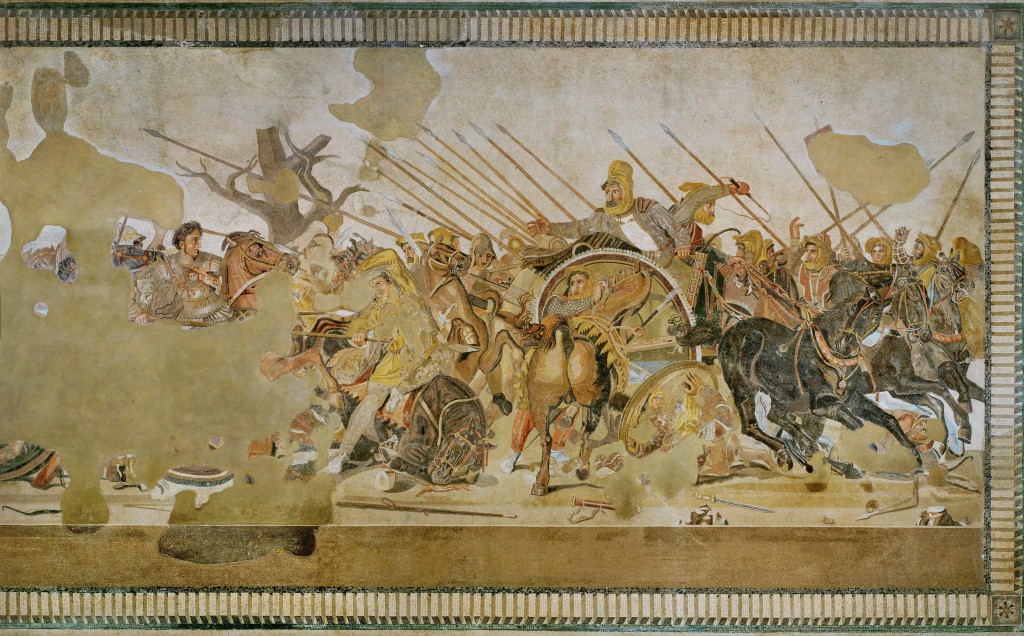 Pompeii floor mosaic depicting Alexander and Darius III at the Battle of Issus (November 333 BC) (Source: Public Domain). Known often as the “Mosaico di Alessandro” (Mosaic of Alexander) The above is a Roman copy of its Greek original that had been crafted by Philoxenos of Eretria.
Pompeii floor mosaic depicting Alexander and Darius III at the Battle of Issus (November 333 BC) (Source: Public Domain). Known often as the “Mosaico di Alessandro” (Mosaic of Alexander) The above is a Roman copy of its Greek original that had been crafted by Philoxenos of Eretria.
From Aristobulus, whose witness is often invoked, came the following information: (a) The order of battle of Darius III’s army at Gaugamela: the different peoples composing the left and right wings are enumerated; in the center was the Great King himself with his kinsmen, picked guard, etc. (ibid., 3.11.3ff.). (b) Description of the tomb of Cyrus the Great at Pasargadae (a description recognized as exact in modern times). Alexander, finding the tomb profaned and damaged, gave the order to Aristobulus to repair everything and to restore the monument (ibid., 6.20.4-8). (c) The account of the weddings at Susa, especially the marriages of Alexander to Barsine, the eldest daughter of Darius III, and to Parysatis, the youngest daughter of Artaxerxes III, when he was already married to Roxane, daughter of the Bactrian Oxyatres (ibid., 7.4.4).
Among Arrian’s other sources was Nearchus of Crete. After the conquest of India Nearchus was assigned the duty of bringing the Greek fleet from the mouth of the Indus to Susa. The work that Nearchus composed describing this long voyage was to furnish Arrian with the essential material for his History of India (Indica), which is, in fact, the history of one of the stages of Alexander’s expedition. (On the facts of the periplus of Nearchus, see W. Capelle, “Nearchus” no. 3, in Pauly-Wissowa, XVI/2, 1935, cols. 2185ff.; Pearson, op. cit., pp. 112-49; W. Spoerri, “Nearchos,” in Der Kleine Pauly IV, 1972, pp. 33-34.) Nearchus described the banks along which his fleet passed, their ports, water courses, and islands, and he cites the distances between points. He discusses the coasts of the “fisheaters” south of Gedrosia (Tūrān and Makurān), of Carmania (Kermān) (chaps. 32-37), of the Persians (Fārs) (chaps. 38-39), and of the Susians (Ḵūzestān). Then followed, after the mouth of the Euphrates, the passage upward from Pasitigris (Kārūn) and the rendezvous of Nearchus’ fleet and Alexander’s army near a bridge of boats (chap. 24) near modern Ahvāz (cf. G. Le Rider, Suse sous les Séleucides et les Parthes, Paris, 1965, p. 264). The itinerary from there to Susa is found in Anabasis 7.7.1-2. This description contains valuable ethnological and climatic details. This History of India also preserves several indigenous place names more or less faithfully: Neoptana, Hormozeia (Hormuz), on the coast of Carmania (chap. 33); the mountain Ochus (Vahuka), Apostana, Gogana, on the coast of the Persians (chap. 38); the island of Margastana, along the littoral of the Susians (chap. 41).
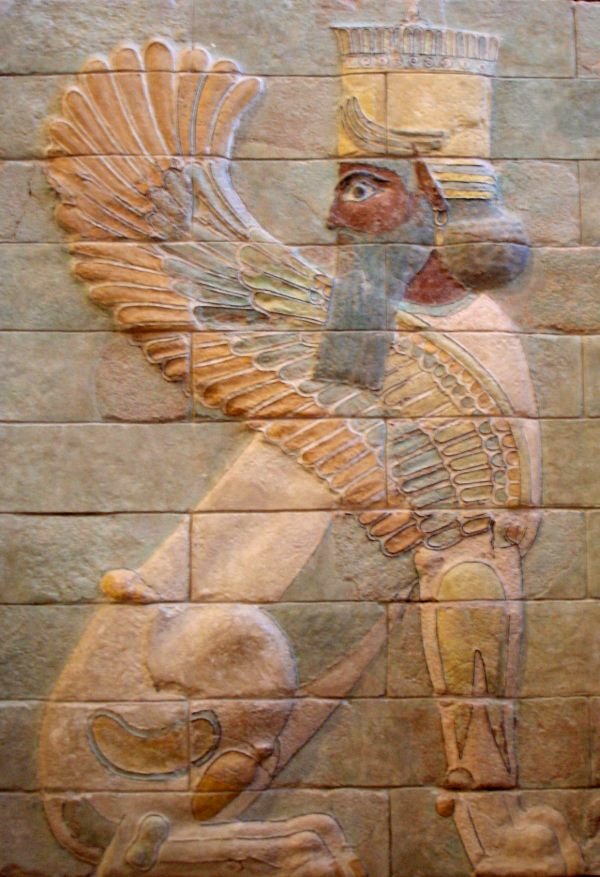 Winged Sphinx of Darius at Susa (Source: Public Domain).
Winged Sphinx of Darius at Susa (Source: Public Domain).
The History of Events after Alexander (in ten books) has not survived. It is known through a long summary by Photius (Bibliotheca 92; ed. R. Henry, II, pp. 20-33) and through fragments (ed. A. G. Roos and G. Wirth, II, pp. 253-86; F. Jacoby, Die Fragmente der griechischen Historiker II, Berlin, 1929, pp. 840-51, 872-73, 874, 881-83. The work in four books of Dexippus of Athens (3rd cent. A.D.) on the same subject seems to have been an epitome of the History of Arrian (see F. Jacoby, op. cit., II C: Kommentar, Berlin, 1926, pp. 306-07; we possess from it a brief summary also by Photius (Bibliotheca 82, ed. R. Henry, I, pp. 188-90). The work, in ten books, is devoted to events from 323 to 321, notably to the two successive partitions of the Achaemenid territories and to their consequences. Most of the actual Iranian satrapies passed into the hands of the Macedonian generals. However, some Persians were among the beneficiaries of these partitions.
The Parthica or History of the Parthians is also lost. Arrian was not ignorant of the Parthians. At the time when he governed Cappadocia, the Alan peril may have brought together briefly Parthians and Romans. But when Dio Cassius (Historia romana 69.15) speaks of the intervention of Vologases in those circumstances, it is not easy to determine whether he is concerned with the king Vologases II (III) of Parthia or rather his parent and homonym, the king of Armenia (for the latter identification, see A. von Gutschmid, Geschichte Irans und seiner Nachbarländer, Tübingen, 1888, p. 147). In writing a History of the Parthians, his essential goal was to set down the different phases of Trajan’s Parthian war (114-17). Of this work, in 17 books, Photius has preserved only a brief notice (Bibliotheca 58; ed. R. Henry, I, Paris, 1959, pp. 51-52). But the important fragments preserved by the Suda (Suidas) and Stephan of Byzantium help to partially reestablish its contents (ed. Roos-Wirth, II, 1968, pp. 223-52). See especially the erudite study of A. G. Roos (Studia), and now C. Coppola, “I Parthica d’Arriano nella biblioteca di Fozio,” Studia in memoria di R. Cantarella, Università di Salerno, 1981, pp. 475-91).
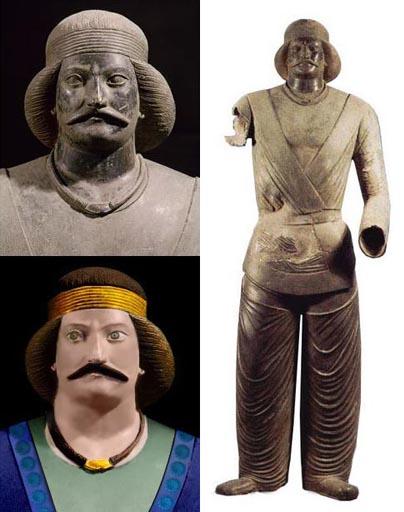 A reconstruction of the face on the statue of a Parthian nobleman housed at Tehran’s Iran Bastan Museum (Picture Source: Parthian Empire).
A reconstruction of the face on the statue of a Parthian nobleman housed at Tehran’s Iran Bastan Museum (Picture Source: Parthian Empire).
The first seven books dealt with the period before Trajan: Book I. Origin and customs of the Parthians; the first Arsacids. Arrian gives as ancestor of this dynasty Arsaces, son of Phriapites (frag. I, Roos-Wirth, p. 225 = Photius, Bibliotheca 58, ed. Henry, I, p. 51). This ancestry seems confirmed, to a certain extent, by some Parthian ostraca recently discovered at Nisa. Indeed in the formula of this document the Arsacid king appears as a grandson or great-grandson of Friyapatak (= Phriapites) (cf. M. L. Chaumont, Syria 48, 1971, pp. 145ff.). Book II. The war of Crassus against the Persians and the battle of Carrhae (53 B.C.). Book IV. Mark Antony’s expedition into Media Atropatene (36 B.C.). Book V. Roman-Parthian relations under Augustus, Tiberius, and Claudius. Book VI. Corbulo’s campaign into Armenia. Book VII. Relations of Romans and Parthians under the Flavians; the complaints voiced against Trajan by the Arsacid Pacorus II (frag. 32; Roos-Wirth, p. 235).
The account of Trajan’s expedition is contained in books VIII-XVII: Book VIII. Armenian campaign of 114; the attitude of the Roman emperor toward the Arsacid aspirants to the throne of Armenia, Parthamasiris and Axidares (frags. 37-40; Roos, p. 237). Book IX. Mesopotamian campaign (114-l5); many village names mark Trajan’s itinerary from Edessa to Babylonia. In Books XI-XVI he includes, in chronological order: the taking of Ctesiphon, the voyage down the Tigris by the Roman fleet in the direction of the Persian Gulf, the short-lived success in Mesene and Characene, the return to Ctesiphon and Babylonia (116). An interesting fragment survives from the history of the revolt of the Parthian and Armenian princes, concerning the Armenian king, Sanatruces (Sanatruk) (frag. 59; Roos-Wirth, p. 247). In the last book (XVII) were described the siege of Hatra and subsequent events up to the return to Syria.
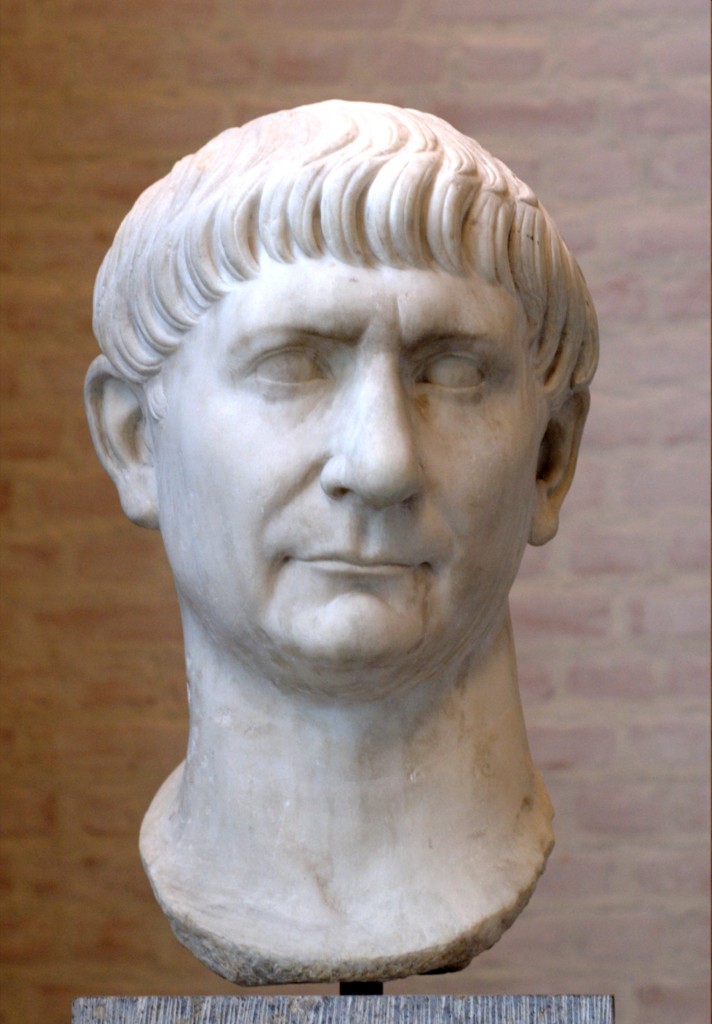 Roman Emperor Trajan as depicted in a marble bust (r. 98-117 CE) (Source: Public Domain).
Roman Emperor Trajan as depicted in a marble bust (r. 98-117 CE) (Source: Public Domain).
Although the History of the Parthians probably reflected only the Roman point of view, nevertheless its loss is regrettable. Everything indeed inclines us to believe that Arrian, thanks to his high connections, would have had first-hand access to official and private documents. The few fragments that remain from the original work have been put to good use by modern historians. See N. C. Debevoise, A Political History of Parthia, Chicago, 1936, p. 278 (index); J. Guey, Essai sur la guerre parthique de Trajan, Bibliothèque d’Istros II, Bucarest, 1937, p. 153 (index); G. Wirth, “Zur Tigrisfahrt des Kaisers Trajan,” Philologus 102, 1963, pp. 288-300.
 Partho-Sassanian belt buckle dated to the 2nd or 3rd century CE (Picture source: Farrokh, page 143, Shadows in the Desert: Ancient Persia at War-Персы: Армия великих царей-سایههای صحرا–).
Partho-Sassanian belt buckle dated to the 2nd or 3rd century CE (Picture source: Farrokh, page 143, Shadows in the Desert: Ancient Persia at War-Персы: Армия великих царей-سایههای صحرا–).
Bibliography
Editions of Arrian’s work: Arriani Anabasis et Indica, ed. F. Dübner, Paris, 1848.
Flavii Arriani quae existant omnia (Teubner ed.), ed. A. G. Roos and G. Wirth, Leipzig, 1968, I: Alexandri Anabasis; II: Scripta minora et fragmenta (contains the History of India, the fragments of the History of the Parthians). Anabasis Alexandri, with an English translation by E. Iliff Robson (Loeb Class. Library), 2 vols., Cambridge, Mass., and London, 1958-61.
Secondary sources: E. Kornemann, Die Alexandergeschichte des Königs Ptolemaios von Ägypten, Berlin, 1935.
M. Luedeke, De fontibus quibus usus Arrianus composuit (Leipziger Studien II), 1882.
L. Pearson, The Lost Histories of Alexander the Great (Philological Monographs XX), New York, 1960.
A Robinson, The History of Alexander the Great (Brown University Studies 16), Providence, 1953.
A. G. Roos, Studia Arriania, Leipzig, 1912.
E. Schwartz, “Arrianus” no. 9, in Pauly-Wissowa, I, 1894, cols. 1230-47; “Aristobolus” no. 4, ibid., cols. 911-18.
W. Vincent, The Voyage of Nearchus, Oxford, 1809.
F. Wenger, Die Alexandergeschichte des Aristobulos von Kassandreia, Würzburg, 1914.
G. Wirth, “Arrianus,” in Der kleine Pauly I, 1964, pp. 605-06.
Idem, “Ptolemaios I als Historiker,” in Pauly-Wissowa, XXIII, 1959, cols. 2467ff.; Der kleine Pauly IV, 1972, col. 1228.
A. B. Bosworth, A Historical Commentary on Arrian’s History of Alexander (Books I-III) I, Oxford, 1980.
R. Syme, “The Career of Arrian,” Harvard Studies in Classical Philology 86, 1982, pp. 181-211.



